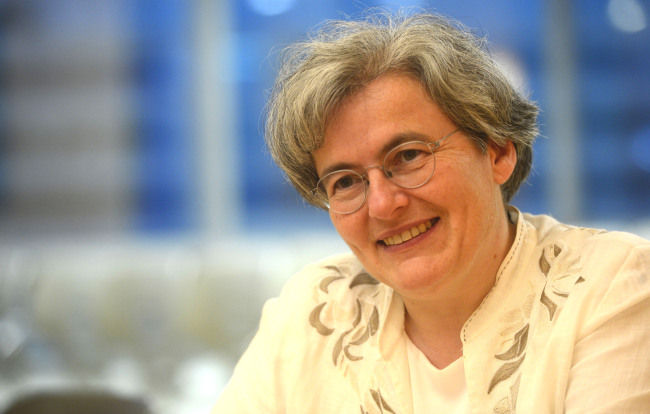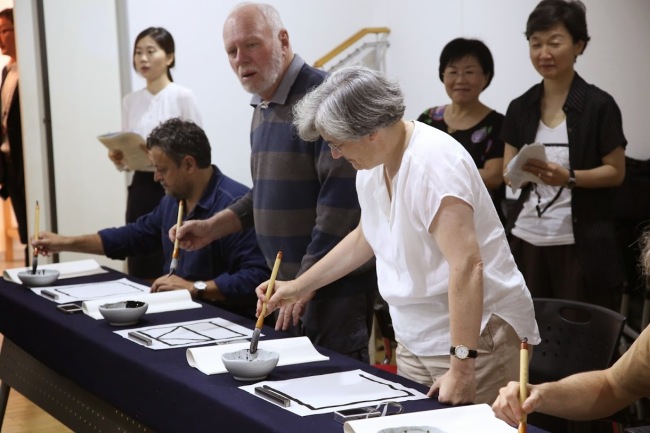How do you renovate a popular 18th-century museum with minimum disruption to the visitors? Hotel Biron, the Paris location of the two-site Rodin Museum in France, has undertaken just that challenge with its two-year renovation.
“The building was in very bad condition and the renovation was an opportunity to strengthen the structure,” said Catherine Chevillot, director of the Rodin Museum, during an interview with The Korea Herald on Sept. 3 at the Alliance Francaise in Seoul. She was in Seoul to participate in the Culture Communication Forum, an annual event organized by the Corea Image Communication Institute and aimed at introducing Korean culture to opinion leaders from around the world.
Because much of the renovation involves strengthening the building, most of the ongoing work won’t be visible to the visitors, Chevillot explained. “The 18th-century windows will be replaced or restored,” said Chevillot. By 2015, the new museography will make the visitor traffic in the building flow more efficiently.
 |
Catherine Chevillot, Rodin Museum director, speaks during an interview with The Korea Herald on Sept. 3 at the Alliance Francaise in Seoul. (Park Hae-mook/The Korea Herald) |
Improved accessibility is one of the major aims in the renovation of the museum, which opened in 1919. “Accessibility to the disabled was important. We have added lifts and enlarged the doors to accommodate wheelchairs,” Chevillot said. All of this required the permission of the historical building preservation society. Hotel Biron, which receives some 700,000 visitors a year, previously pursued an enlargement project that failed because of its designation as a historical building.
Auguste Rodin installed some of the sculptures himself at the hotel, which originally had only three rooms. “It functioned as a showroom while Rodin lived in a house in Meudon near Paris,” said Chevillot. The house in Meudon is the other location of the Rodin Museum. “The hotel is a more intimate museum,” a quality which she sought to maintain even after the renovation, she said. “It is important to keep the special atmosphere of the building. I don’t want it to become a clinic.”
Hotel Biron is well known for its beautiful garden where many of the larger sculptures are on display, including “The Thinker,” “The Burghers of Calais” and “The Gates of Hell.” “The relationship between the garden and the building is very important,” said Chevillot. The 1,000-square-meter building will have some 500 pieces on display while the garden will present some 25 large bronzes.
At the end of August, new sensorial displays created by three architects were unveiled in the garden, as part of the new education program, which is closely tied to accessibility. “One particularly interesting display has the sculpture to touch as well as the materials. The sounds of a studio and smells are presented as well,” she said.
 |
Chevillot (right) tries her hand at Korean calligraphy on Sept. 1 during the Culture Communication Forum. (CICI) |
“We are developing different types of visits for the deaf, the mentally handicapped and the blind,” Chevillot said. “This is very important. I am fighting at the museum to explain that visitors can learn in ways other than words next to the displays,” she said. In fact, visitors will find no texts on the walls or next to the displays at the renovated museum. “The museum is for people to see, to look (at). We must learn how to step back to understand images.”
While overseeing the major revamp to the 18th-century museum in Paris, Chevillot is also involved in the opening of the Louvre Abu Dhabi in the United Arab Emirates as a member of the museum’s scientific committee.
While there was some resistance and reservations about the project announced in 2007, Chevillot noted that it has “changed the minds of the people there.” Previously a desert as far as art was concerned, the city now boasts several museums and art fairs.
“In the beginning, very few galleries participated in the art fairs and very few people came, mostly men,” Chevillot said. But all that has now changed. “It is a good thing if it can change the way we see each other,” she said of the French museum’s involvement in the Abu Dhabi project.
When the Louvre Abu Dhabi opens at the end of 2015, the Rodin Museum will have an independent room. “We will present the link between Rodin and other civilizations. Rodin had more than 6,000 antique pieces ― Greek, Roman, Egyptian and a small collection of Asian pieces,” Chevillot said. “It will aim to show how art is part of globalization. At the time of Rodin, artists already had an international view.”
In Korea, Plateau, Samsung Museum of Art, has a permanent Rodin collection, consisting the last edition of “The Burghers of Calais” and the seventh edition of “The Gates of Hell.” The sale of limited-edition bronzes ― original bronze editions are limited to 12 ― is a major source of income for the Rodin Museum, which does not receive government funding, although its director is appointed by the culture minister.
“I would like to reactivate links with Rodin Museums around the world. Stanford University’s museum has one of the largest Rodin collections in the world, and there is a Rodin Museum in Philadelphia,” Chevillot said.
Chevillot, who visited a number of museums during her stay in Seoul, counts the Korea Furniture Museum, a museum in Seongbuk-dong dedicated to traditional Korean furniture in a hanok setting, as her favorite here. “You can see immediately that architecture and furniture are contrived in a common way,” she said, noting that this is a global conception.
Of Korean designs, she singled out their simplicity as the most striking feature. Explaining how a traditional house looks simple but is an accumulation of centuries of wisdom, she said, “It is much more complicated to be simple.”
By Kim Hoo-ran, Editorial writer
(
khooran@heraldcorp.com)









